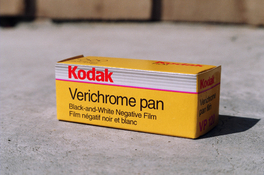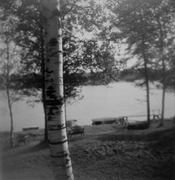You probably mean Plus-X. In fact, Plus-X was available in size 120 but for a short period of time in the 50s.
I am still interested in finding the answer to when the emulsion/development times were changed. I assume that the label in the photo would only be used for a couple of years before photographers became aware of the change.
I can now somewhat locate this change, which basically agrees with the early-1960s deduction that you and Mr Bill arrived at. I have a small stack of Kodak Darkroom Dataguides at different dates (some people collect Leicas, I collect Darkroom Dataguides). The books's dates on the first page are: 1958, 1966 (with minor revs 1969), 1970, 1974, 1979.
Looking at the development numbers for Verichome Pan rollfilm and comparing to other films (eg Tri-X in both rollfilm and 35mm), the 1958 guide has significantly longer development times for Tri-X and Verichrome Pan in both D-76 and Microdol, which are decreased in the 1966-rev-1969 guide. However, Plus-X 135 changes very little. For ex, the VP120 in D-76 time changes from 13 to 6.75 minutes, TX 135 and 120 in D-76 changes from 11 to 7.5 minutes, PX 135 changes from 6.25 to 5.75 minutes.
After the 1966 guide, the numbers change by small amounts for some films (Verichrome Pan decreases again a little from 1970 to 1974), but by significantly less than the 1958-to-1966 change. Also in 1974, Kodak introduced adjustments for different degrees of lens flare and condenser vs diffusion enlargers, recommending a fairly large decrease in time if you were using a condenser enlarger.
At first I was skeptical that the change between 1958 and 1966 is related to the 1961elimination of the ASA safety factor, since that changed film speed numbers. But my understanding is that there were also different definitions of speed (eg ISO based on shadow density vs. ASA on midtone contrast slope), so perhaps reconciling these triggered revisions in the recommended development times.




 plus some 2-3 that I had taken after being given the camera. All came out virtually perfectly with whatever I used for the development time in about 2006/7. Maybe I had asked and was given the time on APUG. I had been given the camera, an Agfa Isolette I, by a friend who had found the camera when clearing out his late brother's house
plus some 2-3 that I had taken after being given the camera. All came out virtually perfectly with whatever I used for the development time in about 2006/7. Maybe I had asked and was given the time on APUG. I had been given the camera, an Agfa Isolette I, by a friend who had found the camera when clearing out his late brother's house
